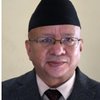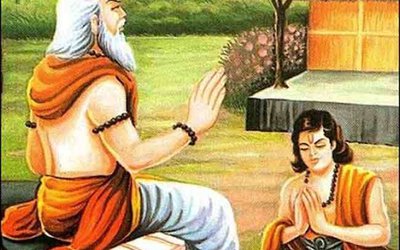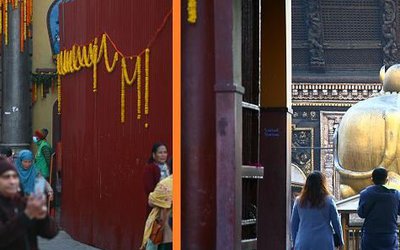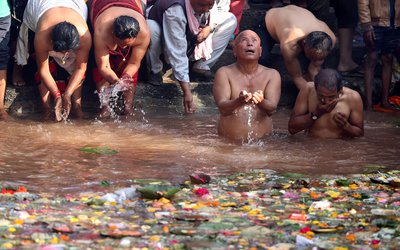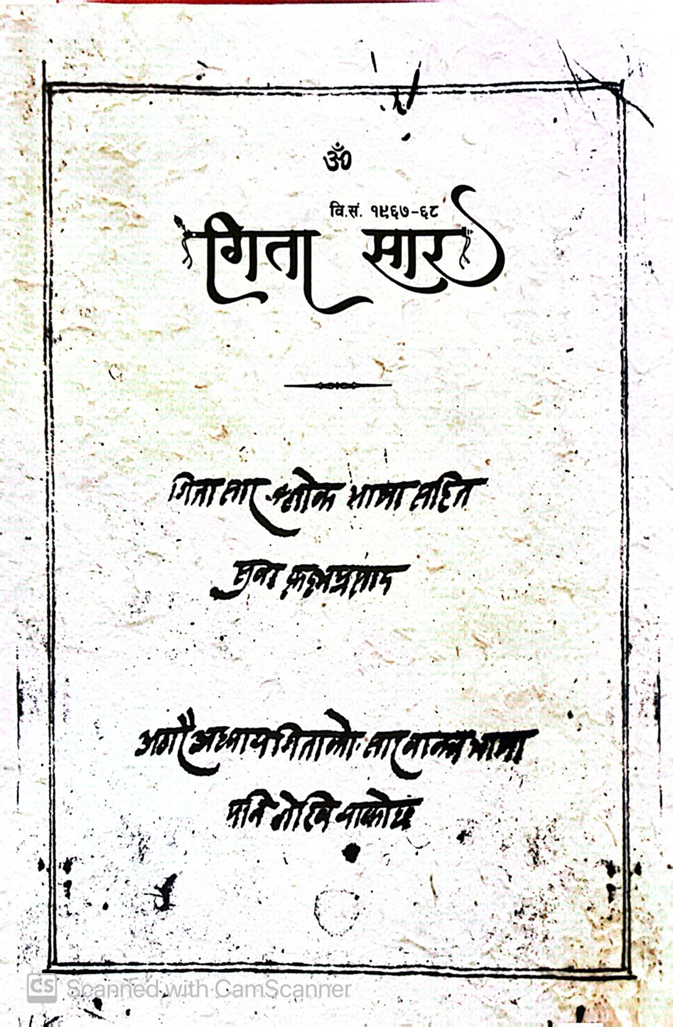
"Tirtha Yatra Dainiki" and "Gita Saar" written by Krishna Prasad Lacoul organized by Palpa Sahitya Samaj, Tansen and "Gita Saar" written around (1937 and 1967-68B.S. ) book release program was held on 3 Baishak 2081 at the premises of Palpa Udyog Banijya Sangh .
The publishers are Banmali Prasad Lacoul , Rup Kishore Lacoul, Sharad Kishore Lacoul and Bharat Kishore Lacoul. The price of 108 pages is kept at Rs.150 and it seems that more is free.
When considering the contemporaries of the neighboring country, it seems that the world of Hindi cinema is written during the time of the contemporaries of Raj Kapoor's father.
Handwritten 'Pilgrimage Diary' and 'Gitasar' by Krishna Prasad Lacoul, such notes, and can be easily read in the contemporary context, and observations have been discussed along with the publication as a work. Recently, Palpa Sahitya Samaj held a discussion on the occasion of its 31st foundation day along with the launch of this work. The manuscripts of the subjects written by Lacoul between 1937 and 1967-1968 have been published as works.
Society president Pushkar Athak Regmi, patron Rajendra Gopal Singh, advisor Chitrawaliram Suwal, publisher/artist's descendants Banmali Lacoul, Rup KishoreLacoul, Bharat Kishore Lacoul, critics Vijay Sagar, Vishwaraj Paudyal and others have jointly launched the work. Inaugurating the historical work, Rajendra Gopal Singh, patron of the society and guest, said that the writer Lacoul was an exceptionally talented religious personality, a wonderful visionary and an innovative thinker. He said, "Even when there was no development and expansion of education at that time, being born in a Newar family and writing works like Pilgrimage Diary , Gitasar, and Taropanishad is not an easy thing.
It should be considered as a wonderful and surprising achievement." He expressed his belief that Nepali literature will be a source of inspiration for future generations.
In the program, the reviewers Vijay Sagar reviewed “Thirthyatra Dainiki” and Vishwaraj Paudyal reviewed Gitasar.
On the same occasion Banmali Lacaul, grandson of writer Krishna Prasad Lacoul, founder of Akshar Purush “ Pustak padhne Dalan” (Dhawal Library) Ambika Prasad Lakaul contributed 1 lakh rupees and Rupkishore Lacoul has also established “Akshaya Kosh” of Rs. 55 thousand 555.
Review of the book Gita Saar
In the book "Gita Saar" the introduction is written by Shanker Man Singh, the foreword by Puskar Athak Regmi, the foreword by Rajendra Gopal Singh, Shubharambha by Lilamani Paudel and the publisher is Banamali Prasad Lakaul and others .
Also, the inclusion of photo copy pictures of the handwritten manuscript of the original text is the main feature of this book. And it is a document of historical importance
In addition, it is based on the original text of the Gita, from which it can be read, although the beginning has made a clear attempt to summarize its essence, not every para is mentioned.
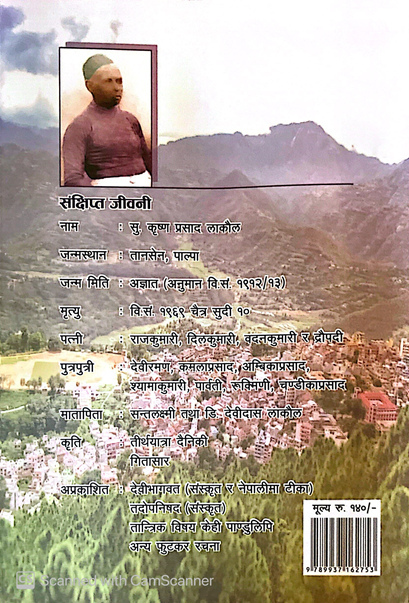
In the preface, Puskar Athak Regmi writes, "From the day of Shravan Shukla Panchami in 1967, he started
writing. These things are written in the front of the manuscript of Gitasara which was completed on the day of Ashadha Krishna Ashtami in 1968. From the mentioned statement, it is proved that Krishna Prasad Lacoul, after studying for a year, translated the essence of eighteen chapters of Gita into Nepali folk language including Sanskrit.
While studying his Gitasar, it becomes clear that although his native language was Nepal, born in a Newar family, Krishna Prasad Lacoul was reputed as an elite scholar who had knowledge of Vedas, Puranas, and grammar with good knowledge of Sanskrit and Khasa (Nepali) language. Rajendra Gopal Singh writes in his best wishes for the book. Ambika Prasad Lacoul , the son of Krishna Prasad Lakaul, who created literature in Nepali language in “Gounda” period in Palpa and raised social awareness, brought educational, political and literary awakening in Palpa by opening a reading hall (Dhawal Library) during the Rana period.
And Lacoul Press was also established and developed printing literature. Lilamani Sharma writes in that book, "A person who performs rituals of “yajna”, charity, penance, and karma according to the scriptures with the sense of Nishkama (karma) is a “manish” person or a yogi.
Mani slokas are said from 93 to 104. Itishree Krishnarjun Samvade Gita Sarasye. Suva Krishna Prasad's translated sloka sartha kishintam. "Yadrisham books drishtva tadrisham likitmaya.. If the river is clean or dirty. 1.
Write the verse as it was, interpret it according to your opinion, forgive the pure and the impure, even if you are afraid, God does not blame you. After that again Shri Ganeshaya Namah.. Om Namah Paramatmanya. Starting from Krishna Prasad Lacoul’s Gita study regretful summaries are presented.
Towards the end of the work, in addition to the Gitasara, with examples of Garuda Purana and Nithishloka, the work is concluded by saying "Iti Gayo Kya Gayo Kavyasastra Vinodena: Kalo Kachchati Dhimtan Vesnesu Moorhanam Nidraya Kalhopi Va Shubhamangalamastu". He says, "In conclusion, Srimad Bhagavat Gitasara has been drawn in the work. Ramayana, Mahabharata yoga, Vedas, study of Sanskrit grammar, the work prepared by the writer Krishna Prasad Lacoul in the current time will remain as ethical religious literature in the field of current literature.
The work is useful for all who are concerned with religion, culture, Purana, moral truth, literature and education. This world is stuck in Sanatan Dharma and Shri Vishnu is considered as Sanatan in Gitasara.
Subba Krishna Prasad wrote about 113 years ago "Gita Saar Bhasha Sang" also reflects his attitude towards spirituality, religion and philosophy even at that time.
Even in that difficult situation where communication is lacking, this kind of creation is a feeling of great pride and honor for the Nepali people and especially for the Palpali and Lacoul family.
Even when he was in the government job, his faith, loyalty and dedication to religion was evident by his offering, dedication and dedication.
In this sense, it is not an exaggeration to say that Krishna Prasad's spiritual writings are not only his biography but a reflection of the spiritual biography of that period.
Although there are many materials available regarding the Gita, but this new work has been quoted from different sources of the Upanishad, Gita and explained in its own style.
It is expected that the readers will be born with a blind thought and contribute to the respect towards nature and God. In the presented work, the author in 61 letters (paragraphs) respectively: Sri Krishna 1, Sri Ananta 2, Sri Vamana 3, Sri Purushottam 4, Sri Vasudeva 5, Sri Rishikesh 6, Sri Madhava 7, Sri Madusudan 8, Sri Damodar 9, Sri Padmanabha 10 , Sri Kesava 11, Sri Garudadhvaja 12, Sri Govinda 13, Sri Achyuta 14, Sri Ananta 15, Sri Aparajit 16, Sri Adhvanksha 17, Sri Jagaddhi 18, Sri Khadgasthi 19, Sri Trailokesha 20, Sri Jagdvande 21, Sri Krishnavarna 22, Sri Trivikrama 23, Sri Narayana 24, Sri Chaturvahu 25, Sri Shankhachakra 26, Sri Gadapadmadhara 27, Sri Peetashwara 28, Sri Vanmala Vibhushit 29, Sri Hey Krishna 30, Sri Hey Ramanath 31, Sri Vrajnath 32, Sri Hey Artinash 33, Sri Hey Padmamudhara 34, Sri Hey Gopal 35, Sri Hey Gokulanath 36, Sri Hey Gopinath 37, Sri Lallab 38, Sri Pundarikaksha 39, Sri Vrahmanna Devaya 40, Sri Vachchang 41, Sri Kaustuvadhar 42, Sri Venukadhar 43, Sri Pati 44, Sri Lakshmipati 45, Sri Vindavan Vihari 46, Sri Tulsipriya 47, Sri Ranganatha 48, Sri Valaram 49, Sri Vasudevasuta 50, Sri Yashodakishore 51, Sri Radharaman 52, Sri Rukminipati 53, Sri Madangopal 54, Sri Vaikunthanath 55, Sri Yadupati 56, Sri Krishna 57, Sri Harihara 58, and others have been written in different ways.
Each letter is preceded by a Sanskrit sloka and an asyartha. At a cursory glance, the following sloka appears in the verses 9-15 of the Upanishad. Since this scripture is full of the juice of the entire Gita, the Gitasara is said to be the juice of the four Vedas in it, which is said to be very holy because of knowledge of Brahman. Because of the four Vedas created by Ved Vyas Muni, eighteen Puranas and Nine Vyakarnas are created, the fifth Veda is composed of the Mahabharata created from the Bharata Sastra, and the essence of the Gita, which has been extracted from the main substance and offered to Arjuna by Lord Krishna, should be read or heard. He has also written that the glimmer of enlightenment will be attained at the best speed.
"The big lamp as religion shows the path of salvation. Take the lamp of your religion and climb the path of salvation. This is the essence of Yogashastra in the Supanishad of Brahma Vidya, the small wise Subba has written that it is fulfilled by the grace of Krishna."
In the year 1967, written on Wednesday, the fifth day of Shravan Shula, 68 years of Ashad Krishna, the eighth day, Hari Om Tatsat Parabrahma Paramatma Sri Harihar Sri Sveshtaprayanamastu, the writer Subba Krishna Prasad has finished an important book like Gita Saar. This material will be historical material. A person is a thought and the rest of the society benefits from it.
- Do Not Talk Too Much Negatively About Nepal!-Success Or Failure Of Nepal: Is It An Economic Problem? -
- Jun 23, 2024
- A Lot Of Heat Day In Nepal!!! Or Has The Summer Temperature Broken The Record So Far?
- Jun 03, 2024
- Nepal's 2081/82 Policy and Programme, Parliament Obstacles:Some Perspectives
- May 16, 2024
- Impact Of Indian Elections In Nepal
- May 03, 2024
- “Thamel And Durbar Marg” Open 24 Hours: Strengths And Weaknesses
- Mar 31, 2024
